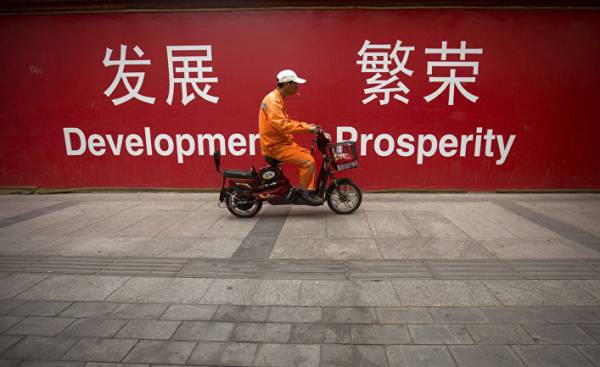
NEW HAVEN — once again the Chinese economy is denied the plaintive wail of the pessimist. After six consecutive years of a slowdown in the growth of real GDP, in 2017 they seem to have started to rise. Just published the figure of GDP growth in the second quarter by 6.9% (annualized) was higher than the growth of 6.7% in 2016 and far above the consensus forecast of international analysts, who only a few months ago was expecting that growth this year will amount to 6.5%, and in 2018 will slow even more — to 6%.
I have long argued that because of the fixation on GDP figures from view overlooked the deeper issues that define the discussion about the growth of the Chinese economy. The reason is that the Chinese economy is in the process of the extraordinary structural transformation: model of the manufacturer based on industry, gives way to the growing power model of the consumer based on the services sector.
Because this process involves a shift in the composition of GDP from the incredibly fast growth of investment and exports to a relatively slower growth in domestic private consumption, the slowdown in GDP growth is both inevitable and desirable. And vulnerability assessment of the Chinese economy should be viewed in that context.
From this debate a long story. I caught it in the first time in the late 1990-ies, during the Asian financial crisis. After Thailand and Indonesia, South Korea and Taiwan, many believed that China will be next. These views were illustrated on the cover of The Economist magazine, published in October 19998 year: Chinese junk draws a powerful whirlpool.
But little could be further from the truth. When the dust settled viral, panregional crisis, the Chinese economy is only slightly swung. Real GDP growth temporarily slowed down (to 7.7% in 1998-1999), but then re-accelerated to 10.3% over the next decade.
Equally revealing was the stability of China during the Great financial crisis. In the period of the most powerful compression of the global economy since the 1930-ies the Chinese economy continued to grow in 2008-2009, the average annual growth was 9.4%. It was below the unsustainable, inflated rates at 12.7%, which were observed during the three years preceding the crisis. But such a fall looks more than reasonable on the background of the 30-year trend of growth observed after 1980: 10%. Moreover, if not the stability of China in the midst of the recent crisis, world GDP would have decreased in 2009 by 0.1% and fell to 1.3%. It would be the sharp slowdown in global activity for the entire postwar period.
Another bout of pessimism about the Chinese economy is focused on two issues — reducing the debt burden and the relative tightening in the property market. In fact, we are talking about the stagnation in the Japanese style. But again, the Western view was out of focus. China, like Japan, has economy with a high savings rate, the increasing debt of the country — it’s basically her duty to herself. But China is thicker than that of Japan, the airbag, which allows to avoid problems with stability.
According to the International monetary Fund, in 2017 the volume of national savings in China is likely to reach 45% of GDP, which is much higher than the savings rate in Japan is 28%. And if Japan, where the gross government debt equal to 239% of GDP, is able to avoid the debt crisis, China, with a much larger volume of savings and a lot less burdened by sovereign debt (49% of GDP), is in much better shape to avoid such a crisis.
Yes, of course, China has a problem with rising corporate debt: the ratio of debt of non-financial sector to GDP at the end of 2016 was estimated at 157% of GDP (compared with 102% at the end of 2008). This means that in the coming years, the reform of state-owned enterprises, which account for the lion’s share of the growing debt will be a priority.
In addition, the Chinese real estate market gives a lot of justified reasons to worry. The growing middle class needs affordable housing. And since the share of urban population in China increased from less than 20% in 1980 to over 56% in 2016 (and likely to approach 70% by 2030), this problem is far from trivial.
But at the same time, this means that the Chinese real estate market, unlike the markets in other major economies that are already fully urbanized, will have good support from the demand side: over the next 10-15 years, the urban population is expected to continue to grow at 1-2% per year. Since 2005, housing prices in China rose almost 50%, which is almost five times higher than the world norm (according to the Bank for international settlements and the global index of housing prices published by the IMF), because the issue of affordable housing is justified. For China the difficulty will be to prudent to ensure increased supply of housing required to meet demand caused by urbanization, but not to indulge in unnecessary speculation and dangerous bubbles in the market.
From the beginning of 2017 the Chinese economy receives additional support from a powerful source of cyclical stability. In June was marked by export growth of 11.3% (year-on-year), which contrasts sharply with the figures of the previous years when it was affected by the negative impact of the weak pace of global economic recovery after the crisis. Meanwhile, an increase of 10% (annualized and inflation-adjusted) in retail sales for the first half of 2017 was 45% higher than the overall GDP growth rate of 6.9%. This indicates an impressive growth in household incomes and the increasing influence of the (probably under-recognized) e-Commerce.
The pessimists used to think the Chinese economy as well as the economy of their countries, repeating the classic mistake, which a historian from Yale University’s Jonathan Spence warned many years ago. Many believe that bubbles on the asset market, such as those that burst in Japan and the United States, pose a similar threat to China. It is also expected that economic growth through increasing debt, what did China recently, will have the same effect as in similar cases in other countries.
Those who makes predictions, it’s hard to resist the urge to try the China developments in major developed countries battered by the crisis. But this approach was incorrect in the past; and he was as wrong today.







